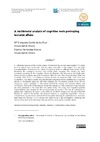Identificador persistente para citar o vincular este elemento:
https://accedacris.ulpgc.es/handle/10553/70383
| Campo DC | Valor | idioma |
|---|---|---|
| dc.contributor.author | Cortés de los Ríos, María Enriqueta | en_US |
| dc.contributor.author | Fernández Alonso, Patricia María | en_US |
| dc.date.accessioned | 2020-02-19T18:26:55Z | - |
| dc.date.available | 2020-02-19T18:26:55Z | - |
| dc.date.issued | 2017 | en_US |
| dc.identifier.issn | 1133-1127 | en_US |
| dc.identifier.uri | https://accedacris.ulpgc.es/handle/10553/70383 | - |
| dc.description.abstract | A multimodal analysis of the communication of terrorism has scarcely been tackled. This study aims to explore how verbal and pictorial modes contribute to the creation of a particular conceptualization of terrorism by means of cognitive tools on different front covers of The Economist, the prestigious business and current affairs magazine. The analysis has been structured according to the Cognitive Theory of Metaphor and Metonymy and Multimodal Discourse (among others, see Lakoff & Johnson, 1980; Johnson, 1987; Evans & Green, 2006; and Forceville, 2009, 2012). Our method of analysis focuses on Forceville (1996, 2009, 2012) and Forceville & Urios-Aparisi (2009), who provide clear instructions for the identification of cognitive devices in multimodal discourse. The data collection for the analysis consists of ten of this magazine’s covers, published in the period 2014-2016, dealing with terrorist attacks and immigration. The results of this analysis reveal that metaphors, metonymies and image schemas are more prevalent in the visual than the verbal mode. This shows how important pictorial representations have become to the communication of terrorism. The use of metonymies is greater than metaphors. By means of the WAR and JOURNEY domains and the use of the FIRE domain to reinforce the former, the terrorist situation is cognitively represented. Colours, considered as cognitive tools which fulfill the evaluative meaning of a particular topic, have also been taken into account. In our analysis they stand out as a sign of negativity reinforcing the horrors of war and the threat towards the people trying to escape an uncertain future. | en_US |
| dc.language | eng | en_US |
| dc.relation.ispartof | LFE. Revista de Lenguas para Fines Específicos | en_US |
| dc.source | LFE. Revista de lenguas para fines específicos [eISSN 2340-8561], v. 23 (2), p. 359-383 | en_US |
| dc.subject | 570107 Lengua y literatura | en_US |
| dc.subject | 550510 Filología | en_US |
| dc.subject.other | Terrorism communication | en_US |
| dc.subject.other | Metaphor | en_US |
| dc.subject.other | Metonymy | en_US |
| dc.subject.other | Multimodality | en_US |
| dc.subject.other | Image schemas | en_US |
| dc.title | A multimodal analysis of cognitive tools portraying terrorist affairs | en_US |
| dc.type | info:eu-repo/semantics/article | en_US |
| dc.type | Article | en_US |
| dc.identifier.doi | 10.20420/rlfe.2017.186 | en_US |
| dc.investigacion | Artes y Humanidades | en_US |
| dc.type2 | Artículo | en_US |
| dc.identifier.ulpgc | Sí | es |
| dc.description.esci | ESCI | |
| dc.description.dialnetimpact | 0,0 | |
| dc.description.dialnetq | Q3 | |
| dc.description.dialnetd | D6 | |
| dc.description.erihplus | ERIH PLUS | |
| item.fulltext | Con texto completo | - |
| item.grantfulltext | open | - |
| Colección: | Artículos | |
Visitas
43
actualizado el 09-mar-2024
Descargas
57
actualizado el 09-mar-2024
Google ScholarTM
Verifica
Altmetric
Comparte
Exporta metadatos
Los elementos en ULPGC accedaCRIS están protegidos por derechos de autor con todos los derechos reservados, a menos que se indique lo contrario.
